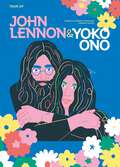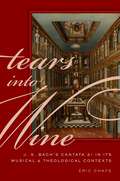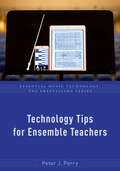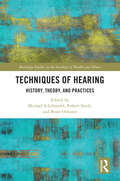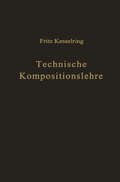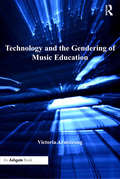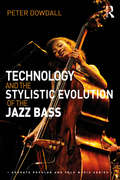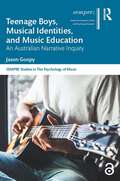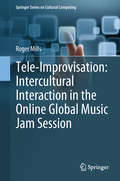- Table View
- List View
Team Up: John Lennon & Yoko Ono (Team Up)
by Francesca Ferretti de BlonayLondon, 1966. Pop music has transformed England's cultural landscape, and rock'n'roll has propelled The Beatles to the very top of the music charts.One day, lead singer and founder of the band John Lennon, met the artist Yoko Ono and their lives changed forever. They fell madly in love, becoming the centre of each other's universes and beginning one of history's most iconic partnerships.John and Yoko's work together on art and music produced projects that made headlines and have stood the test of time, as well as their commitment to world peace and campaigning to make the world a better place.A brand new series, Creative Partners/Team Up, celebrating the most iconic and important collaborations in history.From painters to singers, musicians, activists, athletes and trend setters, these books will show you how magic can happen when two talents meet, with accessible, easy-to-read text telling the stories of these partnerships and the brilliant creations they produced.This series pays tribute to sharing your talent with others, to achieving excellent together, and working as a team to create something special: behind every shining star, hides another one with potential to shine even brighter.
Tear Down the Walls: White Radicalism and Black Power in 1960s Rock
by Patrick BurkeFrom the earliest days of rock and roll, white artists regularly achieved fame, wealth, and success that eluded the Black artists whose work had preceded and inspired them. This dynamic continued into the 1960s, even as the music and its fans grew to be more engaged with political issues regarding race. In Tear Down the Walls, Patrick Burke tells the story of white American and British rock musicians’ engagement with Black Power politics and African American music during the volatile years of 1968 and 1969. The book sheds new light on a significant but overlooked facet of 1960s rock—white musicians and audiences casting themselves as political revolutionaries by enacting a romanticized vision of African American identity. These artists’ attempts to cast themselves as revolutionary were often naïve, misguided, or arrogant, but they could also reflect genuine interest in African American music and culture and sincere investment in anti-racist politics. White musicians such as those in popular rock groups Jefferson Airplane, the Rolling Stones, and the MC5, fascinated with Black performance and rhetoric, simultaneously perpetuated a long history of racial appropriation and misrepresentation and made thoughtful, self-aware attempts to respectfully present African American music in forms that white leftists found politically relevant. In Tear Down the Walls Patrick Burke neither condemns white rock musicians as inauthentic nor elevates them as revolutionary. The result is a fresh look at 1960s rock that provides new insight into how popular music both reflects and informs our ideas about race and how white musicians and activists can engage meaningfully with Black political movements.
Tear Down the Walls: White Radicalism and Black Power in 1960s Rock
by Patrick BurkeFrom the earliest days of rock and roll, white artists regularly achieved fame, wealth, and success that eluded the Black artists whose work had preceded and inspired them. This dynamic continued into the 1960s, even as the music and its fans grew to be more engaged with political issues regarding race. In Tear Down the Walls, Patrick Burke tells the story of white American and British rock musicians’ engagement with Black Power politics and African American music during the volatile years of 1968 and 1969. The book sheds new light on a significant but overlooked facet of 1960s rock—white musicians and audiences casting themselves as political revolutionaries by enacting a romanticized vision of African American identity. These artists’ attempts to cast themselves as revolutionary were often naïve, misguided, or arrogant, but they could also reflect genuine interest in African American music and culture and sincere investment in anti-racist politics. White musicians such as those in popular rock groups Jefferson Airplane, the Rolling Stones, and the MC5, fascinated with Black performance and rhetoric, simultaneously perpetuated a long history of racial appropriation and misrepresentation and made thoughtful, self-aware attempts to respectfully present African American music in forms that white leftists found politically relevant. In Tear Down the Walls Patrick Burke neither condemns white rock musicians as inauthentic nor elevates them as revolutionary. The result is a fresh look at 1960s rock that provides new insight into how popular music both reflects and informs our ideas about race and how white musicians and activists can engage meaningfully with Black political movements.
Tears into Wine: J. S. Bach's Cantata 21 in its Musical and Theological Contexts
by Eric ChafeIn 1714, the 29 year-old Johann Sebastian Bach was promoted to the position of concertmaster at the ducal court of Weimar. This post required him for the first time in his already established career to produce a regular stream of church cantatas-one cantata every four weeks. Among the most significant works of this period is Ich hatte viel Bekümmernis in meinem Herzen (Cantata 21). Generally known in English as "I had much affliction," Cantata 21 draws from several psalms and the Book of Revelations and offers a depiction of the spiritual ascent of the soul from intense tribulation to joy and exaltation. Although widely performed and loved by musicians, Cantata 21 has endured much criticism from scholars and critics who claim that the piece lacks organizational clarity and stylistic coherence. In Tears into Wine, renowned Bach scholar Eric Chafe challenges the scholarly consensus, arguing that Cantata 21 is an exceptionally carefully designed work, and that it displays a convergence of musical structure and theological purpose that is paradigmatic of Bach's sacred work as a whole. Drawing on a wide range of Lutheran theological writing, Chafe shows that Cantata 21 reaches beyond the scope of the individual liturgical occasion to voice a breadth of meaning that encompasses much of the core of Lutheran thought. Chafe artfully demonstrates that instead of simply presenting a musical depiction of the soul's journey from sorrow to bliss, Cantata 21 expresses the various stages of God's revelation and their impact on the believing soul. As a result, Chafe reveals that Cantata 21 has a formal design that mirrors Lutheran belief in unfolding revelation, with the final movement representing the work's "crown"--the goal toward which all of the earlier movements are directed. Complete with full text translations of the cantata and the liturgical readings that would have accompanied it at the first performance, Tears into Wine is a monumental book that is ideally suited for Bach scholars and students, as well as those generally interested in the relationship between theology and music.
Tears into Wine: J. S. Bach's Cantata 21 in its Musical and Theological Contexts
by Eric ChafeIn 1714, the 29 year-old Johann Sebastian Bach was promoted to the position of concertmaster at the ducal court of Weimar. This post required him for the first time in his already established career to produce a regular stream of church cantatas-one cantata every four weeks. Among the most significant works of this period is Ich hatte viel Bek?mmernis in meinem Herzen (Cantata 21). Generally known in English as "I had much affliction," Cantata 21 draws from several psalms and the Book of Revelations and offers a depiction of the spiritual ascent of the soul from intense tribulation to joy and exaltation. Although widely performed and loved by musicians, Cantata 21 has endured much criticism from scholars and critics who claim that the piece lacks organizational clarity and stylistic coherence. In Tears into Wine, renowned Bach scholar Eric Chafe challenges the scholarly consensus, arguing that Cantata 21 is an exceptionally carefully designed work, and that it displays a convergence of musical structure and theological purpose that is paradigmatic of Bach's sacred work as a whole. Drawing on a wide range of Lutheran theological writing, Chafe shows that Cantata 21 reaches beyond the scope of the individual liturgical occasion to voice a breadth of meaning that encompasses much of the core of Lutheran thought. Chafe artfully demonstrates that instead of simply presenting a musical depiction of the soul's journey from sorrow to bliss, Cantata 21 expresses the various stages of God's revelation and their impact on the believing soul. As a result, Chafe reveals that Cantata 21 has a formal design that mirrors Lutheran belief in unfolding revelation, with the final movement representing the work's "crown"--the goal toward which all of the earlier movements are directed. Complete with full text translations of the cantata and the liturgical readings that would have accompanied it at the first performance, Tears into Wine is a monumental book that is ideally suited for Bach scholars and students, as well as those generally interested in the relationship between theology and music.
TECH TIPS FOR ENSEMBLE TEACHERS EMT C (Essential Music Technology:The Prestissimo Series)
by Peter J. PerryWritten by veteran music educator Peter J. Perry, Technology Tips for Ensemble Teachers presents a collection of practical tips to help today's school music ensemble director incorporate and implement technology in all aspects of large ensemble instruction. This go-to guide offers specific methods for the use of technology in ensemble instruction, identifies applicable technologies, and details proven ways to successfully use those technologies in instruction. Tips throughout the book vary in type and complexity, allowing directors of all technical abilities to use the book effectively to meet the unique needs of their ensembles and students. They also offer content-specific examples for technologies in band, orchestra, jazz ensemble, and chorus instruction, as well as emerging ensemble settings such as percussion ensembles, guitar ensembles, rock bands, a capella groups, and iPad ensembles. With a special focus on current technologies including mobile devices, Technology Tips for Ensemble Teachers is a timely and useful resource for directors as students and classrooms become ever more technology-oriented.
The Technique of Orchestration: Pearson New International Edition
by Kent Kennan Donald GranthamThe Technique of Orchestration, Seventh Edition, is the definitive textbook on the study of orchestration, offering a concise, straight-to-the-point approach that prepares students to score their own compositions with confidence. Updated to reflect developments in instruments and orchestral best practices, this seventh edition features: Copious musical examples spanning the history of the orchestra Detailed descriptions of instruments and their distinctive characteristics Explanations of how to score chords and transcribe piano idioms Discussions on specialized ensembles and scoring techniques New musical examples have been added throughout and listening lists have been revised to include more music by women and composers of color, representing a diverse musical catalogue. Supported by an accompanying workbook of scores and scoring exercises (available separately), as well as a robust listening program keyed to the textbook, The Technique of Orchestration, Seventh Edition, is an accessible, essential, all-in-one resource for the student of orchestration.
The Technique of Orchestration
by Kent Kennan Donald GranthamThe Technique of Orchestration, Seventh Edition, is the definitive textbook on the study of orchestration, offering a concise, straight-to-the-point approach that prepares students to score their own compositions with confidence. Updated to reflect developments in instruments and orchestral best practices, this seventh edition features: Copious musical examples spanning the history of the orchestra Detailed descriptions of instruments and their distinctive characteristics Explanations of how to score chords and transcribe piano idioms Discussions on specialized ensembles and scoring techniques New musical examples have been added throughout and listening lists have been revised to include more music by women and composers of color, representing a diverse musical catalogue. Supported by an accompanying workbook of scores and scoring exercises (available separately), as well as a robust listening program keyed to the textbook, The Technique of Orchestration, Seventh Edition, is an accessible, essential, all-in-one resource for the student of orchestration.
Technique of Orchestration, The: Pearson New International Edition
by Kent Kennan Donald GranthamAs in the earlier editions, the emphasis is on the practical fundamentals of orchestration. The Sixth Edition has been expanded and revised to reflect new developments in instruments and orchestral practice, and a new listening compact disc has been added that contains selected examples of orchestration.
The Technique of Orchestration Workbook
by Kent Kennan Donald GranthamThe Technique of Orchestration Workbook, Seventh Edition, accompanies the textbook of the same name—the definitive resource on the study of orchestration—providing musical excerpts, full scores, and scoring assignments to enrich the lessons learned in the textbook. Spanning an array of periods and styles, the musical examples collected here cover scoring techniques in the following sections: Strings Woodwinds Brass Scoring of Chords Transcribing Piano Music Scoring for Woodwinds, Horns, and Strings Percussion Harp and Keyboard Instruments Scoring for Full Orchestra Additional learning tools include transposition exercises, error detection drills, and discussions on harmonics, while the workbook pages are perforated throughout for ease of use in and out of the classroom. Featuring the music of Bach, Mozart, Brahms, Beethoven, Schumann, Copland, Bartók, and many more, The Technique of Orchestration Workbook, Seventh Edition, is an invaluable companion to the textbook.
The Technique of Orchestration Workbook
by Kent Kennan Donald GranthamThe Technique of Orchestration Workbook, Seventh Edition, accompanies the textbook of the same name—the definitive resource on the study of orchestration—providing musical excerpts, full scores, and scoring assignments to enrich the lessons learned in the textbook. Spanning an array of periods and styles, the musical examples collected here cover scoring techniques in the following sections: Strings Woodwinds Brass Scoring of Chords Transcribing Piano Music Scoring for Woodwinds, Horns, and Strings Percussion Harp and Keyboard Instruments Scoring for Full Orchestra Additional learning tools include transposition exercises, error detection drills, and discussions on harmonics, while the workbook pages are perforated throughout for ease of use in and out of the classroom. Featuring the music of Bach, Mozart, Brahms, Beethoven, Schumann, Copland, Bartók, and many more, The Technique of Orchestration Workbook, Seventh Edition, is an invaluable companion to the textbook.
Techniques of Hearing: History, Theory and Practices
by Michael Schillmeier, Robert Stock, and Beate OchsnerHearing, health and technologies are entangled in multi-faceted ways. The edited volume addresses this complex relationship by arguing that modern hearing was and is increasingly linked to and mediated by technological innovations. By providing a set of original interdisciplinary investigations that sheds new light on the history, theory and practices of hearing techniques, it is able to explore the heterogeneous entanglements of sound, hearing practices, technologies and health issues. As the first book to bring together historians, scholars from media studies, social sciences, cultural studies, acoustics and neuroscientists, the volume discusses modern technologies and their decisive impact on how ‘normal’ hearing, enhanced and smart hearing as well as hearing impairment have been configured. It brings both new insights into the histories of hearing technologies as well as allowing us to better understand how enabling hearing technologies have currently been unfolding an increasingly hybrid ecology engaging smart hearing devices and offering stress-free hearing and acoustic wellbeing in novel auditory environments. The volume will be of interest to all scholars and students of disability studies, sound studies, sociology of health and illness, medical history, health and society as well as those interested in the practices and techniques of self-monitored and smart hearing.
Techniques of Hearing: History, Theory and Practices
by Michael Schillmeier Robert Stock Beate OchsnerHearing, health and technologies are entangled in multi-faceted ways. The edited volume addresses this complex relationship by arguing that modern hearing was and is increasingly linked to and mediated by technological innovations. By providing a set of original interdisciplinary investigations that sheds new light on the history, theory and practices of hearing techniques, it is able to explore the heterogeneous entanglements of sound, hearing practices, technologies and health issues. As the first book to bring together historians, scholars from media studies, social sciences, cultural studies, acoustics and neuroscientists, the volume discusses modern technologies and their decisive impact on how ‘normal’ hearing, enhanced and smart hearing as well as hearing impairment have been configured. It brings both new insights into the histories of hearing technologies as well as allowing us to better understand how enabling hearing technologies have currently been unfolding an increasingly hybrid ecology engaging smart hearing devices and offering stress-free hearing and acoustic wellbeing in novel auditory environments. The volume will be of interest to all scholars and students of disability studies, sound studies, sociology of health and illness, medical history, health and society as well as those interested in the practices and techniques of self-monitored and smart hearing.
Technische Kompositionslehre: Anleitung zu technisch-wirtschaftlichem und verantwortungsbewußtem Schaffen
by Fritz KesselringTechnology and the Gendering of Music Education
by Victoria ArmstrongCritical of technologically determinist assumptions underpinning current educational policy, Victoria Armstrong argues that this growing technicism has grave implications for the music classroom where composition is often synonymous with the music technology suite. The use of computers and associated compositional software in music education is frequently decontextualized from cultural and social relationships, thereby ignoring the fact that new technologies are used and developed within existing social spaces that are always already delineated along gender lines. Armstrong suggests these gender-technology relations have a profound effect on the ways adolescents compose music as well as how gendered identities in the technologized music classroom are constructed. Drawing together perspectives from the sociology of science and technology studies (STS) and the sociology of music, Armstrong examines the gendered processes and practices that contribute to how students learn about technology, the repertoire of teacher and student talk, its effect on student confidence and the issue of male control of technological knowledge. Even though girls and female teachers have technological knowledge and skill, the continuing material and symbolic associations of technology with men and masculinity contribute to the perception of women as less able and less interested in all things technological. In light of the fact that music technology is now central to many music-making practices across all sectors of education from primary, secondary through to higher education, this book provides a timely critical analysis that powerfully demonstrates why the relationship between gender and music technology should remain an important empirical consideration.
Technology and the Gendering of Music Education
by Victoria ArmstrongCritical of technologically determinist assumptions underpinning current educational policy, Victoria Armstrong argues that this growing technicism has grave implications for the music classroom where composition is often synonymous with the music technology suite. The use of computers and associated compositional software in music education is frequently decontextualized from cultural and social relationships, thereby ignoring the fact that new technologies are used and developed within existing social spaces that are always already delineated along gender lines. Armstrong suggests these gender-technology relations have a profound effect on the ways adolescents compose music as well as how gendered identities in the technologized music classroom are constructed. Drawing together perspectives from the sociology of science and technology studies (STS) and the sociology of music, Armstrong examines the gendered processes and practices that contribute to how students learn about technology, the repertoire of teacher and student talk, its effect on student confidence and the issue of male control of technological knowledge. Even though girls and female teachers have technological knowledge and skill, the continuing material and symbolic associations of technology with men and masculinity contribute to the perception of women as less able and less interested in all things technological. In light of the fact that music technology is now central to many music-making practices across all sectors of education from primary, secondary through to higher education, this book provides a timely critical analysis that powerfully demonstrates why the relationship between gender and music technology should remain an important empirical consideration.
Technology and the Stylistic Evolution of the Jazz Bass (Ashgate Popular and Folk Music Series)
by Peter DowdallTechnology and the Stylistic Evolution of the Jazz Bass traces the stylistic evolution of jazz from the bass player’s perspective. Historical works to date have tended to pursue a ‘top down’ reading, one that emphasizes the influence of the treble instruments on the melodic and harmonic trajectory of jazz. This book augments that reading by examining the music’s development from the bottom up. It re-contextualizes the bass and its role in the evolution of jazz (and by extension popular music in general) by situating it alongside emerging music technologies. The bass and its technological mediation are shown to have driven changes in jazz language and musical style, and even transformed creative hierarchies in ways that have been largely overlooked. The book’s narrative is also informed by investigations into more commercial musical styles such as blues and rock, in order to assess how, and the degree to which, technological advances first deployed in these areas gradually became incorporated into general jazz praxis. Technology and the Jazz Bass reconciles technology more thoroughly into jazz historiography by detailing and evaluating those that are intrinsic to the instrument (including its eventual electrification) and those extrinsic to it (most notably evolving recording and digital technologies). The author illustrates how the implementation of these technologies has transformed the role of the bass in jazz, and with that, jazz music as an art form.
Technology and the Stylistic Evolution of the Jazz Bass (Ashgate Popular and Folk Music Series)
by Peter DowdallTechnology and the Stylistic Evolution of the Jazz Bass traces the stylistic evolution of jazz from the bass player’s perspective. Historical works to date have tended to pursue a ‘top down’ reading, one that emphasizes the influence of the treble instruments on the melodic and harmonic trajectory of jazz. This book augments that reading by examining the music’s development from the bottom up. It re-contextualizes the bass and its role in the evolution of jazz (and by extension popular music in general) by situating it alongside emerging music technologies. The bass and its technological mediation are shown to have driven changes in jazz language and musical style, and even transformed creative hierarchies in ways that have been largely overlooked. The book’s narrative is also informed by investigations into more commercial musical styles such as blues and rock, in order to assess how, and the degree to which, technological advances first deployed in these areas gradually became incorporated into general jazz praxis. Technology and the Jazz Bass reconciles technology more thoroughly into jazz historiography by detailing and evaluating those that are intrinsic to the instrument (including its eventual electrification) and those extrinsic to it (most notably evolving recording and digital technologies). The author illustrates how the implementation of these technologies has transformed the role of the bass in jazz, and with that, jazz music as an art form.
Technology for Unleashing Creativity: Practical Tips and Tools for Music Educators (Essential Music Technology: The Prestissimo Series)
by Steve GiddingsTraditional music education centered around the ensemble classroom has often privileged reading music and instrumental technique over creative skills such as composition, improvisation, and learning by ear. As the technological landscape of students' everyday lives rapidly shifts, what schools teach rarely aligns with students' more creative day-to-day lives outside of the classroom. While administrators and state education standards often encourage incorporating creative technologies into the music curriculum, many music teachers lack the training to successfully utilize these tools and platforms. In Technology for Unleashing Creativity, author Steve Giddings provides a practical and easily accessible resource for in-service and pre-service K-12 teachers looking to make better use of technology in their teaching and help heighten students' creativity. One of few authors to tackle both issues simultaneously, Giddings offers a guide for inspiring creativity in students through tools like YouTube learning, notation technology, DAWs, electronic instruments, online pedagogical platforms, and more. A technology-driven approach to music education has never been timelier. COVID-19 has significantly disrupted the business-as-usual of educational institutions, and music educators especially have adapted to teaching remotely. Via practical tips, visual diagrams, and lesson plan ideas, Technology for Unleashing Creativity walks music teachers through the core aspects of using technology in their classrooms--in-person and remote--offering a definitive guide to creativity and technology in K-12 music education.
Technology for Unleashing Creativity: Practical Tips and Tools for Music Educators (Essential Music Technology: The Prestissimo Series)
by Steve GiddingsTraditional music education centered around the ensemble classroom has often privileged reading music and instrumental technique over creative skills such as composition, improvisation, and learning by ear. As the technological landscape of students' everyday lives rapidly shifts, what schools teach rarely aligns with students' more creative day-to-day lives outside of the classroom. While administrators and state education standards often encourage incorporating creative technologies into the music curriculum, many music teachers lack the training to successfully utilize these tools and platforms. In Technology for Unleashing Creativity, author Steve Giddings provides a practical and easily accessible resource for in-service and pre-service K-12 teachers looking to make better use of technology in their teaching and help heighten students' creativity. One of few authors to tackle both issues simultaneously, Giddings offers a guide for inspiring creativity in students through tools like YouTube learning, notation technology, DAWs, electronic instruments, online pedagogical platforms, and more. A technology-driven approach to music education has never been timelier. COVID-19 has significantly disrupted the business-as-usual of educational institutions, and music educators especially have adapted to teaching remotely. Via practical tips, visual diagrams, and lesson plan ideas, Technology for Unleashing Creativity walks music teachers through the core aspects of using technology in their classrooms--in-person and remote--offering a definitive guide to creativity and technology in K-12 music education.
Technology Tips for Ensemble Teachers (Essential Music Technology:The Prestissimo Series)
by Peter J. PerryWritten by veteran music educator Peter J. Perry, Technology Tips for Ensemble Teachers presents a collection of practical tips to help today's school music ensemble director incorporate and implement technology in all aspects of large ensemble instruction. This go-to guide offers specific methods for the use of technology in ensemble instruction, identifies applicable technologies, and details proven ways to successfully use those technologies in instruction. Tips throughout the book vary in type and complexity, allowing directors of all technical abilities to use the book effectively to meet the unique needs of their ensembles and students. They also offer content-specific examples for technologies in band, orchestra, jazz ensemble, and chorus instruction, as well as emerging ensemble settings such as percussion ensembles, guitar ensembles, rock bands, a capella groups, and iPad ensembles. With a special focus on current technologies including mobile devices, Technology Tips for Ensemble Teachers is a timely and useful resource for directors as students and classrooms become ever more technology-oriented.
Teenage Boys, Musical Identities, and Music Education: An Australian Narrative Inquiry (ISSN)
by Jason GoopyMusic is a powerful process and resource that can shape and support who we are and wish to be. The interaction between musical identities and learning music highlights school music education’s potential contributions and responsibilities, especially in supporting young people’s mental health and well-being. Through the distinctive stories and drawings of Aaron, Blake, Conor, Elijah, Michael, and Tyler, this book reveals the musical identities of teenage boys in their final year of study at an Australian boys’ school.This text serves as an interface between music, education, and psychology using narrative inquiry. Previous research in music education often seeks to generalise boys, whereas this study recognises and celebrates the diverse individual voices of students where music plays a significant role in their lives. Adolescent boys’ musical identities are examined using the theories of identity work and possible selves, and their underlying music values and uses are considered important guiding principles and motivating goals in their identity construction. A teaching and learning framework to shape and support multiple musical identities in senior secondary class music is presented.The relatable and personal stories in this book will appeal to a broad readership, including music teachers, teacher educators, researchers, and readers interested in the role of music in our lives. Creative and arts-based research methods, including narrative inquiry and innovative draw and tell interviews, will be particularly relevant for research method courses and postgraduate research students.
Teenage Boys, Musical Identities, and Music Education: An Australian Narrative Inquiry (ISSN)
by Jason GoopyMusic is a powerful process and resource that can shape and support who we are and wish to be. The interaction between musical identities and learning music highlights school music education’s potential contributions and responsibilities, especially in supporting young people’s mental health and well-being. Through the distinctive stories and drawings of Aaron, Blake, Conor, Elijah, Michael, and Tyler, this book reveals the musical identities of teenage boys in their final year of study at an Australian boys’ school.This text serves as an interface between music, education, and psychology using narrative inquiry. Previous research in music education often seeks to generalise boys, whereas this study recognises and celebrates the diverse individual voices of students where music plays a significant role in their lives. Adolescent boys’ musical identities are examined using the theories of identity work and possible selves, and their underlying music values and uses are considered important guiding principles and motivating goals in their identity construction. A teaching and learning framework to shape and support multiple musical identities in senior secondary class music is presented.The relatable and personal stories in this book will appeal to a broad readership, including music teachers, teacher educators, researchers, and readers interested in the role of music in our lives. Creative and arts-based research methods, including narrative inquiry and innovative draw and tell interviews, will be particularly relevant for research method courses and postgraduate research students.
Tele-Improvisation: Intercultural Interaction in the Online Global Music Jam Session (Springer Series on Cultural Computing)
by Roger MillsThis research monograph explores the rapidly expanding field of networked music making and the ways in which musicians of different cultures improvise together online. It draws on extensive research to uncover the creative and cognitive approaches that geographically dispersed musicians develop to interact in displaced tele-improvisatory collaboration. It presents a multimodal analysis of three tele-improvisatory performances that examine how cross-cultural musician’s express and perceive intentionality in these interactions, as well as their experiences of distributed agency and tele-presence.Tele-Improvisation: Intercultural Interaction in the Online Global Music Jam Session will provide essential reading for musician’s, postgraduate students, researchers and educators, working in the areas of telematic performance, musicology, music cognition, intercultural communication, distance collaboration and learning, digital humanities, Computer Supported Cooperative Work and HCI.
Television's Marquee Moon (33 1/3)
by Bryan WatermanA thoroughly researched study of the origins of the New York City punk scene, focusing on Television and their extraordinary debut record.
